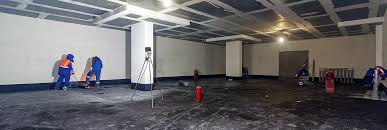A leaky basement can be a homeowner’s nightmare, leading to a host of problems ranging from mold growth to structural damage. Understanding the causes, identifying the signs, and knowing how to effectively repair basement leaks are crucial steps in maintaining a dry and healthy home. Here’s what you need to know about basement leak repair.
Common Causes of Basement Leaks
-
Poor Drainage: Inadequate drainage around the foundation can lead to water accumulation. This is often caused by improperly installed gutters, downspouts that discharge too close to the foundation, or poorly graded landscapes that direct water toward the home.
-
Hydrostatic Pressure: When water accumulates in the soil around your home, it creates hydrostatic pressure that can force water through cracks and porous areas in the basement walls and floor.
-
Cracks in Foundation: Over time, foundations can develop cracks due to settling, shifting, or thermal expansion and contraction. These cracks provide an easy entry point for water.
-
Faulty Plumbing: Leaking pipes, water heaters, or other plumbing fixtures can cause water to seep into the basement.
-
Window Wells: Poorly installed or maintained window wells can allow water to pool and leak into the basement through the window frames.
Identifying Signs of Basement Leaks
-
Visible Water: Puddles or wet spots on the basement floor are the most obvious signs of a leak.
-
Damp Walls: Damp or wet walls, especially near the floor or foundation, indicate water intrusion.
-
Musty Odor: A persistent musty smell is often a sign of mold or mildew caused by moisture.
-
Efflorescence: This white, powdery substance on walls is caused by water evaporating and leaving behind mineral deposits.
-
Mold Growth: Mold and mildew thrive in damp environments. If you see mold growth, it’s a clear sign of moisture issues.
-
Peeling Paint: Paint or wallpaper that is bubbling, peeling, or blistering indicates underlying moisture problems.
Steps for Effective Basement Leak Repair

-
Identify the Source: Determine where the water is coming from. This may require inspecting the exterior of your home, checking the grading, and examining the basement walls and floor for cracks.
-
Improve Exterior Drainage:
- Gutters and Downspouts: Ensure gutters are clean and downspouts extend at least 6 feet away from the foundation.
- Grading: The ground around your home should slope away from the foundation to prevent water from pooling near the basement walls.
- French Drains: Install French drains or other drainage systems to divert water away from your home.
-
Seal Cracks and Gaps:
- Epoxy or Urethane Injections: Use epoxy or urethane injections to seal cracks in the foundation walls and floor.
- Waterproof Sealant: Apply a waterproof sealant to the interior walls to prevent moisture penetration.
-
Install Interior Drainage Systems:
- Sump Pump: Installing a sump pump can help manage groundwater and prevent it from entering the basement.
- Interior Drain Tiles: Interior drain tile systems collect water and direct it to a sump pump, effectively keeping the basement dry.
-
Repair Plumbing Issues: Fix any leaking pipes, faucets, or other plumbing fixtures that may be contributing to basement moisture.
-
Maintain Window Wells:
- Covers: Install window well covers to keep out rain and debris.
- Drainage: Ensure window wells have proper drainage systems to prevent water buildup.
Professional vs. DIY Basement Leak Repair
DIY Repairs: Minor leaks caused by small cracks or poor drainage can often be addressed by homeowners using DIY methods such as sealing cracks, improving gutter systems, and regrading the landscape. However, these solutions may only provide temporary relief.
Professional Repairs: For more serious issues, such as significant foundation cracks, extensive water damage, or persistent leaks, it’s advisable to hire a professional. Basement waterproofing specialists can conduct a thorough inspection, identify the root cause of the leaks, and implement long-lasting solutions.
Preventative Measures
- Regular Maintenance: Regularly inspect and maintain your home’s drainage systems, including gutters, downspouts, and landscape grading.
- Monitor Foundation: Keep an eye on the foundation for any signs of cracks or settling.
- Moisture Barriers: Consider installing moisture barriers in the basement to reduce humidity levels.
- Dehumidifiers: Use dehumidifiers to control basement humidity and prevent mold growth

.jpg)










